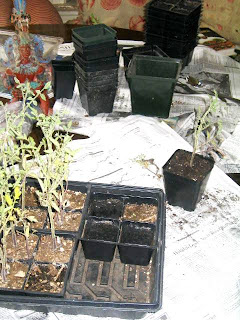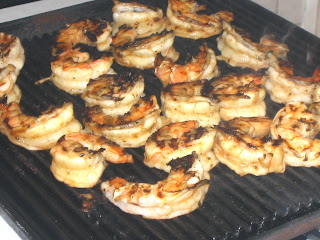 Today's brainteaser is to guess which of the bowls on the left contains the live mussels that we purchased for dinner last night and which bowl contains the dead mussels.
Today's brainteaser is to guess which of the bowls on the left contains the live mussels that we purchased for dinner last night and which bowl contains the dead mussels.If you are thinking this must be a trick question because there couldn't possibly be that many dead mussels in the four bags we took home from Whole Foods...well, then, you lose.
 Because in fact fully half of the mussels we bought last night at our neighborhood Whole Foods were DOA.
Because in fact fully half of the mussels we bought last night at our neighborhood Whole Foods were DOA.This is a bit disconcerting when you have guests over for dinner and all has been wagered on the mussels being pulled from the fridge at the last minute, given a quick wash with the intent of plunging them into the cook pot.
This is doubly concerting when you are trying to do a good turn to the rapidly depleting fish in the oceans by eating shellfish instead.
But no, as my wife stood at the sink giving the mussels the usual dead-or-alive test (she likes to run the mussels under cold water and give the open ones a squeeze to see if they react) all we could hear was her muttering, "dead...dead...dead," and the clink of the shell as she dropped the dead soldier into our stainless steel sink.
Needless to say, the "dead...dead...dead" kept repeating what seemed endlessly, until the muttering stopped and she blurted out, "You know, most of these mussels are dead!"
Well, maybe not quite "most," but at least half. Maybe a bit more than half.
Is that unusual? Is it typical to take home two bags full of mussels and find that half of them have expired? I think so. Pretty unusual.
So while the guests were sipping their wine and munching on some steamed artichoke, I zipped back down to our friendly Whole Foods to replace our mussels. Customer Service sent me directly back to the seafood counter, where I tried to insist that the clerk not only replace at least one of the two bags I'd purchased earlier, but open the bag and check to make sure the mussels were actually alive and edible.
"I can't open any bags," he said.
"You can't?"
"No, I can't open any bags."
He disappeared in the back for a few minutes. I'd brought him the evidence of our dead mussels and he'd spread them out in some sort of tray. I could see him walking back and forth with it behind a glass window.
When the clerk emerged again, he said, "So, you want two more bags? Is that what you want?"
I said that would be fine and left with two completely different bags of mussels, in addition to the ones we'd kept from the earlier two bags.
On the drive home, I stuck my nose into the shopping bags containing the replacement mussels and detected the tell-tale aroma of dead seafood. Not a good sign. I wonder if the clerks behind the seafood counter at Whole Foods ever think to sniff the product they sell before passing it off to the customers...
Once home, the dead-or-alive sifting began again. "Dead...dead...dead," I heard my wife muttering. Again, the clinking of the shells. Again, at least half the mussels were dead. So if you guessed the top picture as the one showing the live mussels, you would be correct. The lower picture shows the dead mussels, all piled in a large colander.
Frankly, I've never seen this kind of a mussel slaughter before the cooking even begins. So I located the original label that had come with the bags of mussels and called the company in Maine whose number was on the label and left a message about what had happened on the voice mail of a woman named Madge.
It was a polite message, a professional courtesy indicating that somewhere along the line--somewhere between being caught and being stored and sold at our local Whole Foods--these mussels had met an untimely demise.
Well, on to the meal. In addition to the steamed artichoke, I deep-fried two pounds of squid, dusting them in corn starch seasoned with salt and garlic salt. The mussels--the live ones--went into a pot where I'd sauteed about three large shallots, diced small, with a stick of butter. For the cooking liquid I had intended to use some Pinot Grigio, but when I got back from Whole Foods I found the guests had drunk the Pinot Grigio, so I cracked open a bottle of Sam Adams Summer Ale instead.
The cooked mussels were distributed in large, shallow bistro bowls with linguine, topped with chopped parsley and a drizzle of extra virgin olive oil. With a salad from the garden on the side, a loaf of French bread to soak up the juices and a cold bottle of Austrian Gruener Veltliner, this was a meal...
And my wife's sour cherry pie for dessert.



























































